WHICH LEATHER TO CHOOSE?
The choice of leather must be made according to the creation to be made. Each animal has its particularities in terms of flexibility, thickness or surface of the skin . It is important to note that each hide is unique and that the mechanical properties of the leather are therefore not identical across the entire surface (especially for bovine leather). Leather is a durable material used in many sectors: leather goods, clothing, saddlery, gloves, shoemaking... It is an inimitable and timeless material. Discover in this guide the different tanning, leather finishes and the particularities specific to each animal.
WHERE TO BUY LEATHER?
Find the ideal leather for your next creation among our wide range of leather skins in varied colors and various finishes. Our goal is to offer quality leathers accessible to everyone.
WELCOME TO THE LEATHER PLANET
50% OF OUR LEATHER COMES FROM CLEARANCE
We find for you end-of-series leathers or old collections from major leather goods manufacturers , shoe brands or luxury brands to offer them for sale. This is why most of our leathers are offered in limited series and this is also what allows us to offer you affordable prices. Without knowing it, you give a "responsible" side to your creations by helping us to recycle this beautiful material - UPCYCLING .
50% OF OUR LEATHER IS MADE FOR YOU
In order to offer you permanent ranges and allow you to perpetuate some of your creations, we have our own ranges of leather manufactured: Satinlys, Sweet 2, Automobile... OUR LEATHER COMES MAINLY FROM EUROPEAN TANNERIES.
THE DIFFERENT TANNINGS
Tanning consists of transforming the skin into leather using tannins, substances of different natures which make it possible to go from putrescible skin to a rot-proof material: leather (source: CNC).
Leather is a durable material used in many sectors: leather goods, gloves, shoemaking, textiles, saddlery... It is an inimitable and timeless material. The term "leather" can only be used when the skin of an animal has been transformed.
|
VEGETABLE TANNING |
MINERAL TANNING (CHROMIUM) The most common method because around 85% of leathers are mineral tanned and therefore require little maintenance. Use of mineral tannins: chrome salts, iron salts... The growth of this tanning is primarily due to a demand from customers who do not accept that a leather bag is damaged due to rain. This should make it possible to avoid regular maintenance. |
 |
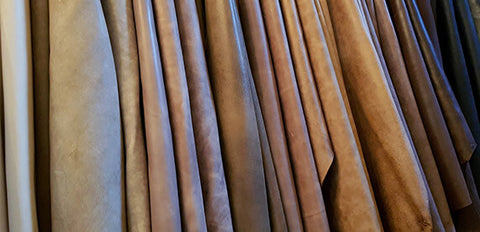 |
COMBINED TANNING
Tanning which combines 2 tanning families to obtain leather which combines the qualities of the tannins used. For example: Vegetable Chrome.
SYNTHETIC TANNING
Use of synthetically produced tannins. The composition is close to that of vegetable tannins.
TANNER OR TANNER?
The material is worked in tanning for bovine leather and in tannery for goat and sheep leather.
- The tanner works with large raw hides (calf, young cattle, cows, young calves, bulls, buffalo).
- The meat maker prepares the small, thinner skins (lamb, sheep, goat, ostrich).
The different parts of bovine leather
Discover our guide which presents the different parts of bovine leather as well as their respective qualities.
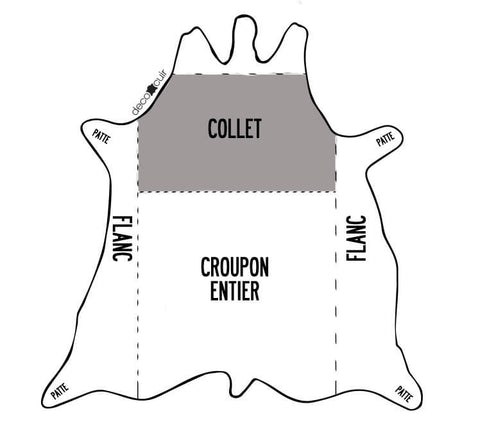
HOW DO I KNOW IF MY LEATHER HAS VEGETABLE OR MINERAL (CHROMIUM) TANNING?
We invite you to watch the video (below) from the Radermercker tannery which explains the flame technique.
This technique consists of burning a piece of your leather: if the ashes are greenish it is mineral tanning. VIDEO SOURCE LINK >
WHAT IS LEATHER AND HOW IS IT MADE?
Several manufacturing steps are necessary to transform a hide into leather: river work (preparation for tanning) , tanning, dyeing and grinding/finishing . To find out more about each step, we invite you to consult the complete guide from the National Leather Council.
LEARN MORE >
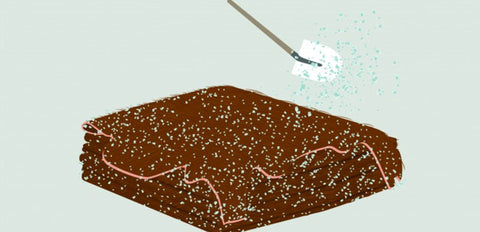 |
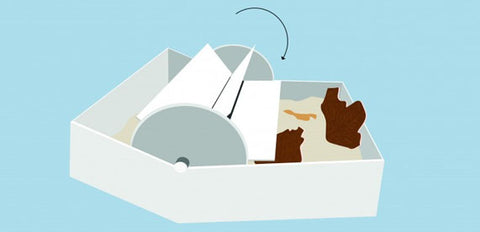 |
| ©Noémie DAVAL - National Leather Council | ©Noémie DAVAL - National Leather Council |
To find out more, we invite you to watch the video of “Les tanneurs français”.
LAYERS OF SKIN
THE MAIN LEATHER FINISHES
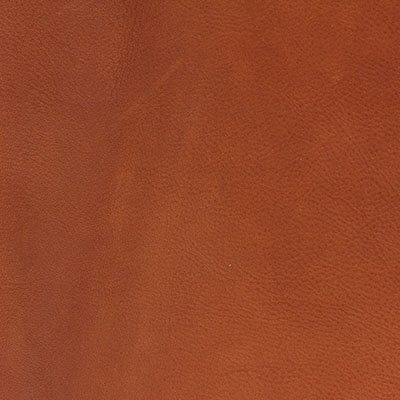 |
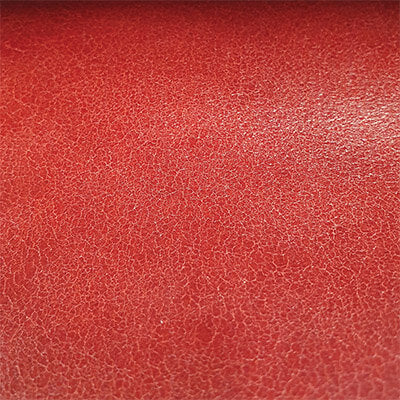 |
 |
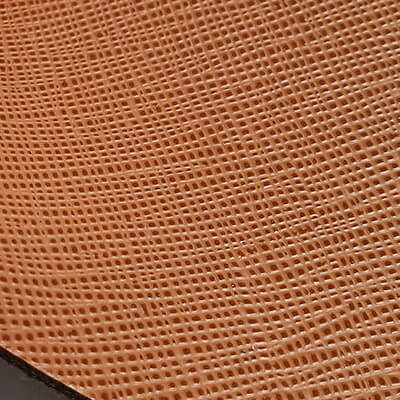 |
|
FULL GRAIN LEATHER Leather having retained its original grain (outer layer intact) . It is the “noblest” leather in the leather family. |
SPLIT LEATHER Leather from which the grain has been removed by splitting. |
VELVET CRUST Velvety-looking product obtained from a crust. |
LEATHER / COATED SPLIT Leather / Crust covered with a thick finish on the surface. The leather has been finished with polyurethane (PU). |
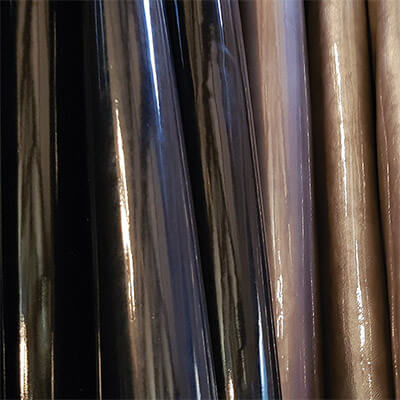 |
 |
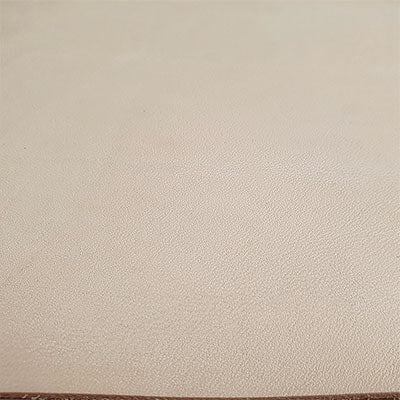 |
 |
|
PATENT LEATHER Leather coated with a layer of varnish or a film (waterproof). |
CORRECTED GRAIN LEATHER Leather whose grain has received light sanding to eliminate defects. It will receive various finishes: pigmented, grained... |
NATURAL LEATHER Leather having no surface finish. |
FANCY LEATHER Leather with an original finish: metallic, imitation crocodile, snake... |
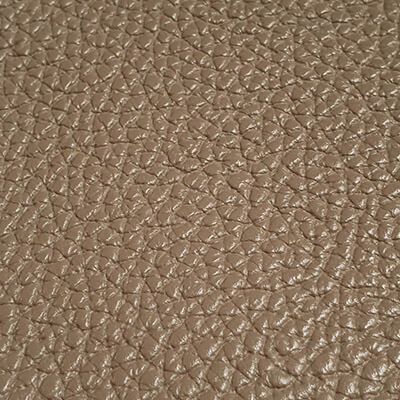 |
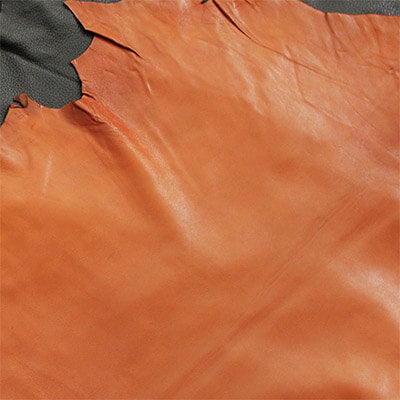 |
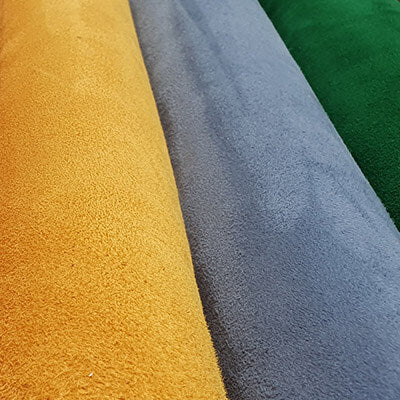 |
 |
|
GRAINED LEATHER** Leather having undergone a graining operation by a tanner (not natural). |
NAPPA LEATHER Soft, smooth, fine and resistant full-grain leather from lambskins, calfskins, etc. |
VELVET LEATHER* Velvety-looking leather obtained by sanding the flesh side (crust - opposite of nubuck). |
NUBUCK LEATHER Velvety-looking leather obtained by sanding the grain. Nubuck leather is a high-end leather: “peach skin”. |
A LITTLE VOCABULARY...
 |
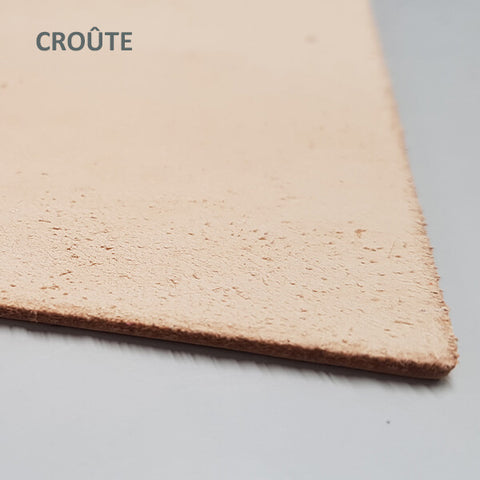 |
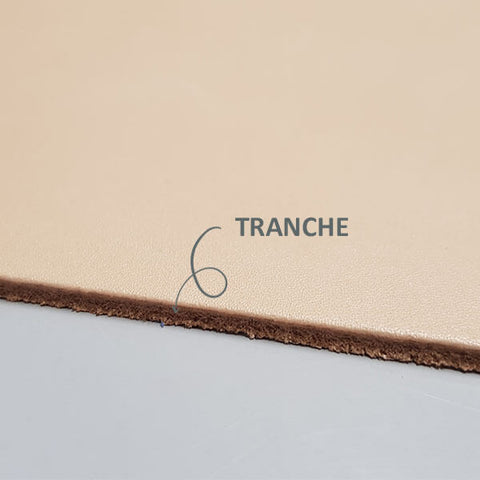 |
|
FLOWER This is the place of a leather: the side of the leather which supports the hair. It is smooth, grained, velvet... |
FLESH SIDE It's the back of the leather, it's quite fluffy. |
SLICE This is the leather side. The edges can be worked with an eraser or edge finisher. |
WHAT IS TILLED LEATHER?
Tumbled leather is leather that has gone through fullers to be softened (a kind of large washing machine that works dry and sometimes with hot air) . This operation can last several hours depending on the suppleness of the leather that you want to obtain.
*WHEN DO WE TALK ABOUT VELVET?
Unlike Nubuck, suede is sanded on the flesh side. This leather has a more fibrous structure than nubuck. It is sometimes called suede or suede*. It is generally made from skins that have a grain with defects in order to transform the reverse side of the skin into suede leather to enhance it. In this case the flower side remains as is, with its defects, because only the suede leather side must be visible in the item created. Suede leather can also be made from split leather. In this case, one side will be velvet, the other can be either raw or velvet. Generally suede leather is quite supple. This leather is often used to make linings, bellows, soft items such as purses, work shoes or gloves. This leather is more economical than full grain leathers.
*It is important to remember that suede leather does not exist - suede is a protected species.
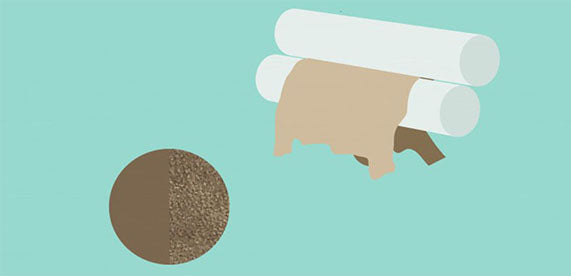 ©Noémie Daval - National Leather Council
©Noémie Daval - National Leather Council
**WHAT IS GRAINED LEATHER?
We must first differentiate between naturally grained leather which will have variations in grain depending on the location of the skin from that which has received pressure treatment and whose grain is very homogeneous at the grain level. The leather is artificially grained to beautify it and give it a personalized style.
The major leather goods brands have created their “own grain” in order to give a signature to their items. These grain patterns are trademarked and must not be counterfeited by leather manufacturers.
Artificially grained leather is strong in nature as these created grains strengthen the grain of the leather. With use, scratches and small scrapes will be less visible than on smooth leather. This leather is therefore generally used for the manufacture of bags, sofas, car seats or shoes.
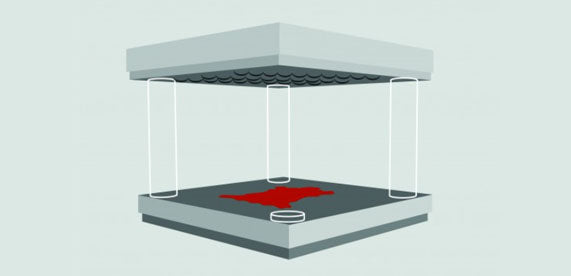 ©Noémie Daval - National Leather Council
©Noémie Daval - National Leather Council
SURFACE FINISHES
After the dyeing work, the leather receives a surface finish (more or less thick film) which aims to protect and beautify the material. This finish is chosen based on the quality of the skin.
WHAT IS ANILINE/DIPPED LEATHER?
This type of finish is reserved for full-grain leather without imperfections : it involves immersing the leather in a bath to tint it in the mass (by dipping). This type of leather retains a silky/waxy feel and will develop a patina over time. The leather retains its natural appearance. Aniline leather is leather without additional finishing, it is more sensitive to stains and friction. It can sometimes receive a thin transparent layer (low thickness) which does not alter the properties of the skin and allows it to be preserved (minimal protection). These components can be based on casein, plasticized shellac, or albumin for example.
WHAT IS SEMI-ANILINE LEATHER?
The semi-aniline leather has received a lightly pigmented protective layer (allows it to resist the sun and bad weather) . This leather is dyed by dipping it in a bath and is covered with a light pigmented layer (also called semi-pigmented leather) and a protective layer (aniline). Imperfections in the leather will be slightly hidden.
Nappa leather is a smooth, full-grain, semi-aniline leather: it has received a surface treatment and is pigmented. It is a supple and robust skin.
WHAT IS PIGMENTED LEATHER?
Pigmented leather is leather that has received several layers of opaque dyes which hide imperfections and therefore make it more resistant. This type of leather often has a glossy appearance. The finish hides flower defects while enhancing the color of the flower.

WHAT IS FIRST AND SECOND CHOICE LEATHER?
Leather is a natural material that includes imperfections such as scars, wrinkle marks, holes, etc. These defects can be positioned anywhere on the skin (each skin is unique). The leather skins sold as first choice may therefore contain some defects but they are usable at a minimum of 75% of their surface area . There is no major defect preventing the manufacture of a part using at least 50% of the surface of the skin.
Second choice leathers are skins/pieces where there may be: marked folds, small imperfections, wrinkles, scars, scratches, small holes or stains. These leathers have more defects than first choice leathers and these defects can be distributed over the entire skin. The skins can be used at a minimum of 50% of their surface area. These skins are intended for the manufacture of small parts which can be positioned around defects in order to make the best use of their surface.
VIEW 2ND CHOICE LEATHER >
DIFFERENT ANIMALS
The most commonly used leathers:
-
Cattle : calf, cow, calf, bull, bison, etc.
Most used, large size, flexible or firm for leather goods, furniture, shoe industry.
-
Sheep: lamb, ewes, mutton
Soft leather, very small and smooth grain, small skin, mainly for clothing, jewelry, luxury items, shoes. Sheep can be worked while retaining its wool.
-
Goats: goat, kid, billy goat, chamois, deer, caribou...
Slightly firm leather (unless it is tumbled), specific grain (naturally quite marked), small hide, mainly for sheathing, leather goods and shoes.
-
Pigs: pork, pig, peccary...
Entry-level leather. Specific grain: leather goods and glove industry lining.
Exotic leathers:
-
Reptilians: iguana, crocodile, alligator, caiman, lizard, chameleon...
Small skin and very regular scale. The cost is very high, which limits its use to luxury items.
-
Snakes and water snakes: python, boa...
Fragile skin requiring reinforcement or lining, leather goods and footwear use.
-
Fish: Nile perch, salmon, shark, dogfish…
Relatively small and thin skins. A sector that has been seeking to develop for several years. Shagreen is fish leather. The leather of shagreen skin is unique and very hard. It is made up of small mineral balls which give it a very particular grain. This leather is also characterized by its central pearl, often white in color, which is very coveted.
-
Various exotic animals: ostrich, kangaroo…
Ostrich skin is the most elaborate of this family, especially appreciated for its appearance with its pimples, which are the marks of the feathers. The ostrich leg is also appreciated for its scaled appearance. It is widely used for small leather goods or watch straps.
 |
 |
 |
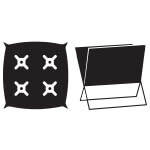 |
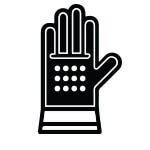 |
| Furnishing | Jewelry | Shoe | Decoration | Gloves |
 |
 |
 |
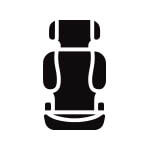 |
| Leather goods | Garment | Binding | Saddlery |

This guide is given for information purposes only; the specificities of each skin must of course be taken into consideration (notably flexibility and thickness). Leather is a noble material made up of small defects (scars, marks, differences in color, etc.) which only serve as a reminder that the material is also alive.
HOW DO WE MEASURE THE SURFACE OF OUR LEATHER SKINS?
The surface area of a skin can be measured in m2 or foot2 (footage). The oldest unit of measurement is the foot: which approximately corresponds to the size of a human foot (1 foot = 0.3048 m - 1 foot2 = 0.0929 m2). For simplicity, we have chosen to give you measurements in m2, the price of our leathers is therefore based on this measurement.
SKIN SIZE TABLE
 To help you choose the size of the skin (in m2), we provide you with a table with values in cm. Please note, this table is provided for information purposes only to give you an idea but does not take into account all the specificities of each skin (specific to each animal). The dimensions given correspond to the size of a rectangular piece that can be cut from the skin (the head, sides and legs are not included in the measurements). Dimensions are approximate. For a specific project, do not hesitate to contact us so that we can check the dimensions.
To help you choose the size of the skin (in m2), we provide you with a table with values in cm. Please note, this table is provided for information purposes only to give you an idea but does not take into account all the specificities of each skin (specific to each animal). The dimensions given correspond to the size of a rectangular piece that can be cut from the skin (the head, sides and legs are not included in the measurements). Dimensions are approximate. For a specific project, do not hesitate to contact us so that we can check the dimensions.
| From 0.10 to 0.20 m² | From 0.20 to 0.30 m² | From 0.30 to 0.40 m² | From 0.40 to 0.50 m² | From 0.50 to 0.60 m² | |
|
SIZE IN CM |
30 x 40 cm | 30 x 45 cm | 35 x 50cm | 40x50cm | 45 x 60 cm |
| From 0.60 to 0.70 m² | From 0.70 to 0.80 m² | From 0.80 to 0.90 m² | From 0.90 to 1 m² | From 1 to 1.10 m² | |
|
SIZE IN CM |
50x60cm | 45 x 70 cm | 60x75cm | 60x80cm | 65 x 85 cm |
| From 1.10 to 1.20 m² | From 1.20 to 1.30 m² | From 1.30 to 1.40 m² | From 1.40 to 1.50 m² | ||
|
SIZE IN CM |
65 x 90 cm | 75x100cm | 75 x 110cm | 75 x 120cm |
HOW DO WE MEASURE THE THICKNESS OF OUR LEATHER?
The thickness of leather is measured with a measuring stick . We offer leather thicknesses ranging from 0.5 to over 3 mm. The thicknesses of the pieces of leather can vary by plus or minus 0.3 mm.
THE CHOICE OF THE THICKNESS OF A LEATHER
Depending on the animal (and its age) the leather can have a maximum thickness of around 2 mm for goat and lamb leathers and 6 mm for cattle. Then, each tanner can refine the leather with machines to reduce its thickness and thus meet the demand of its customers. Generally, the minimum thickness is around 0.5 mm. You should know that the finer the leather, the more it will be affected by deformation. The choice of leather thickness for your creations depends on many factors (technical and aesthetic).
HOW TO MAINTAIN LEATHER?
Leather is a living material that weathers and embellishes. To respect this noble material and maintain its beauty, it is necessary to maintain it regularly. It is important to protect the leather from water, dirt, sunlight (to avoid color changes), and heat (risk of cracking). To do this, you must have a colorless waterproofer (solvent-free – water-based), a glycerin soap to clean the leather and a nourishing milk or grease to nourish and protect the material. Please note that not all leathers are maintained in the same way. For example, suede and nubuck are very fragile and their maintenance is limited to the use of a soft brush or a crepe brush (leather eraser) to scrub imperfections. It is also essential to waterproof them, just like vegetable tanned leather and dipped lambskin. Mineral tanned leather requires little maintenance given the substances used during its transformation. Widely used and known to everyone, shoe polish should only be applied to shoes because it blocks the pores of the leather and prevents it from breathing (risk of cracking) .
SAMPLE REQUEST
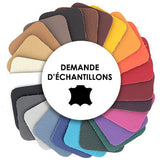
DO YOU HAVE A DOUBT ABOUT THE COLOR OF A LEATHER, LACE OR STRAP?
To get an idea of the color rendering, thickness and suppleness of the leather that we sell in whole skins , we offer the sending of samples. We also offer samples for our leather straps and laces.




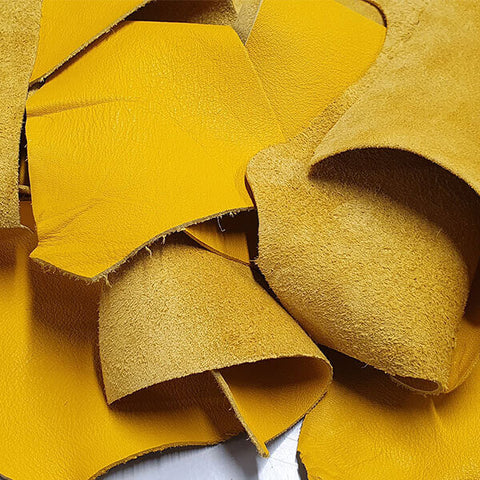
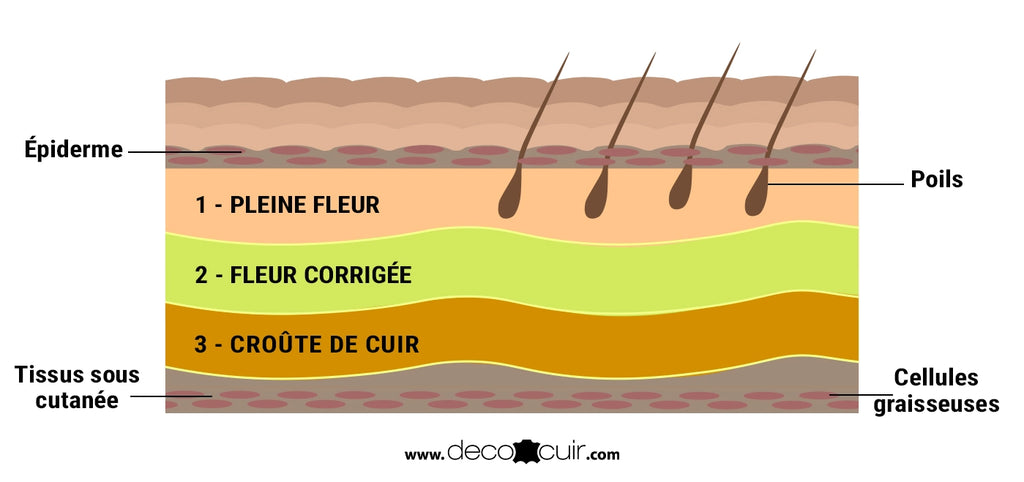







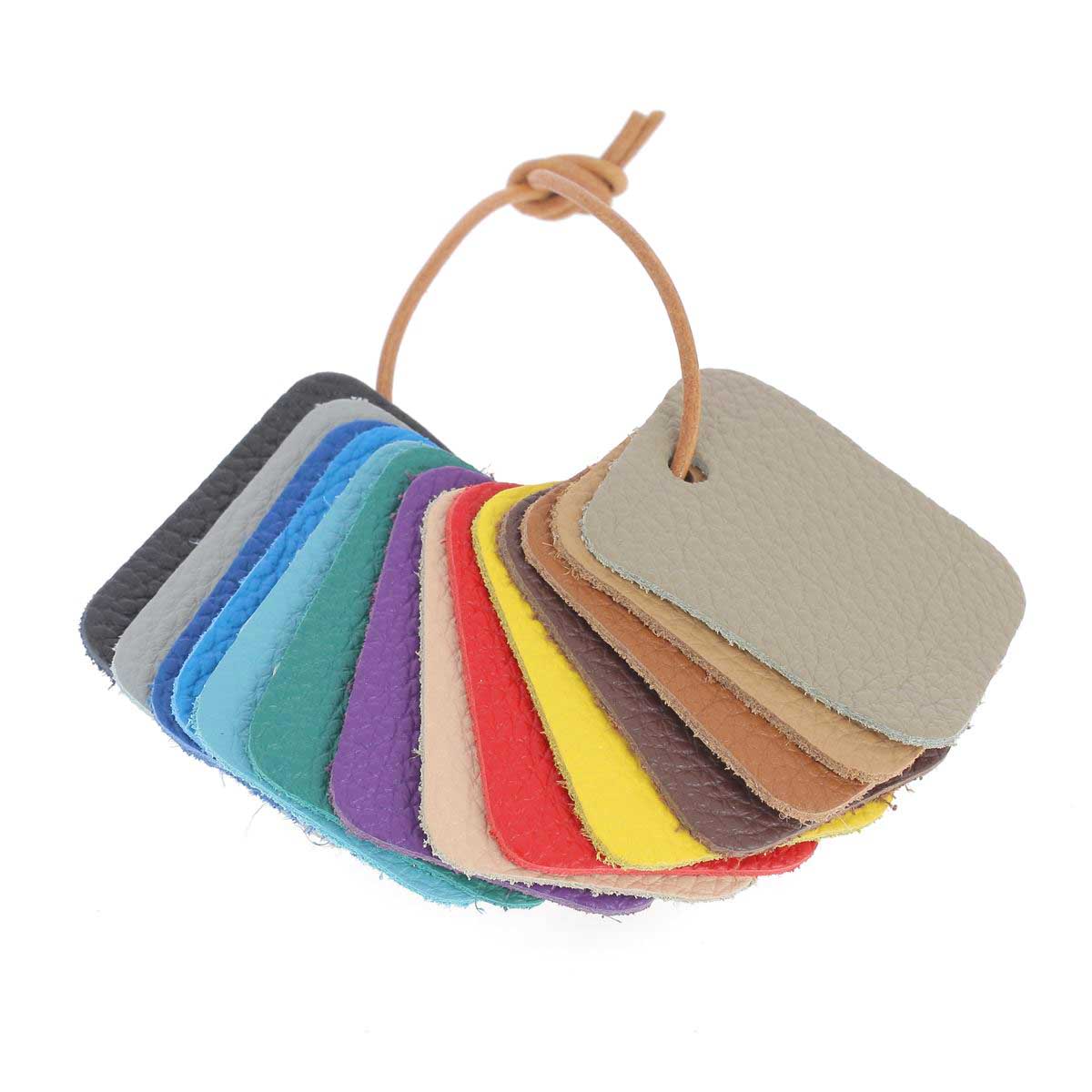
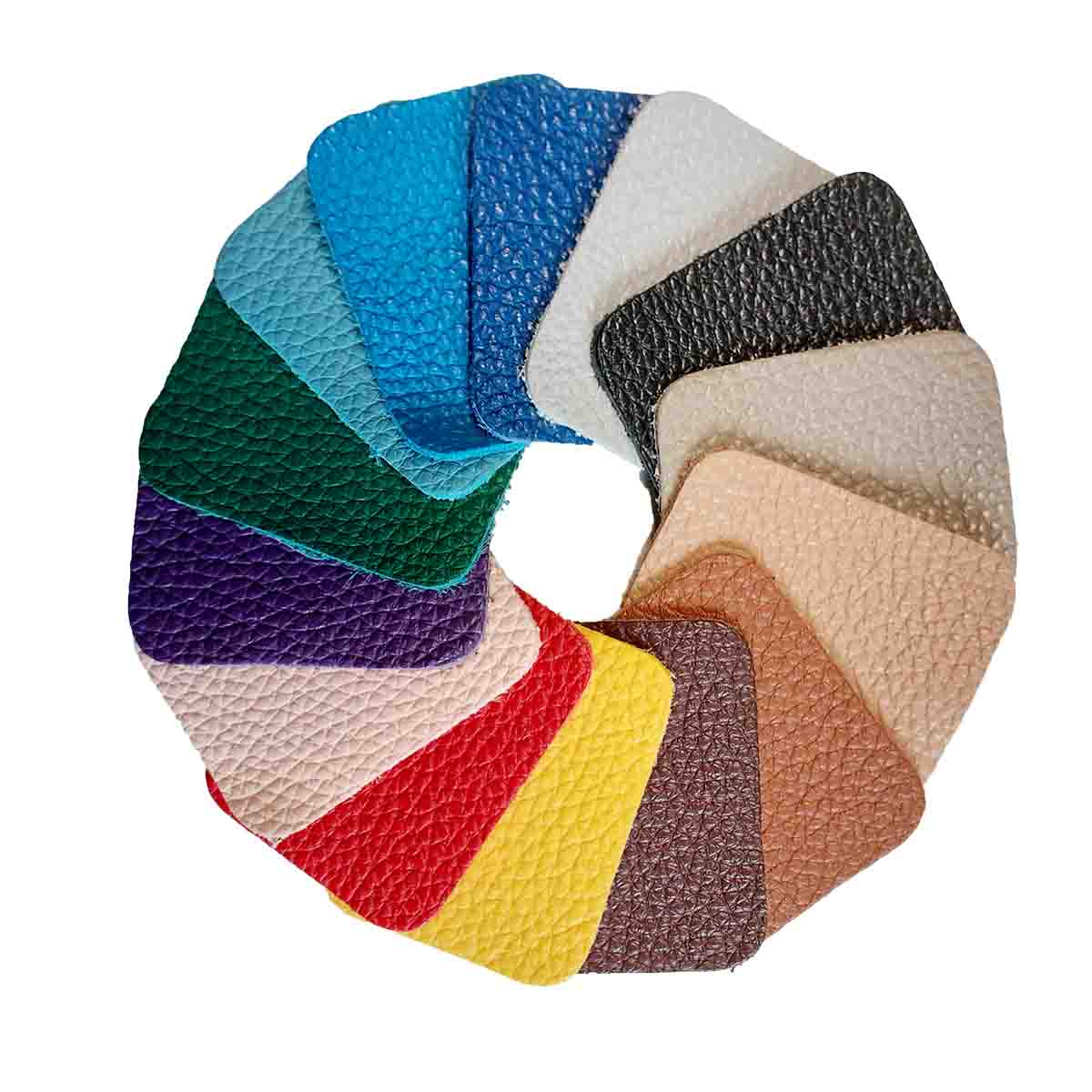


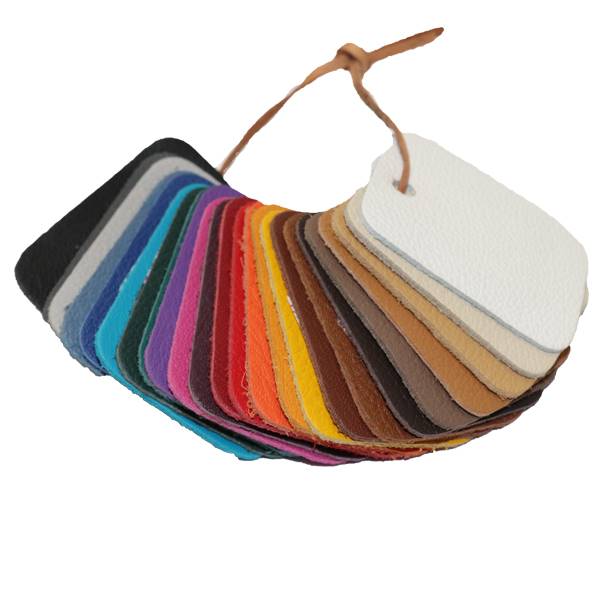
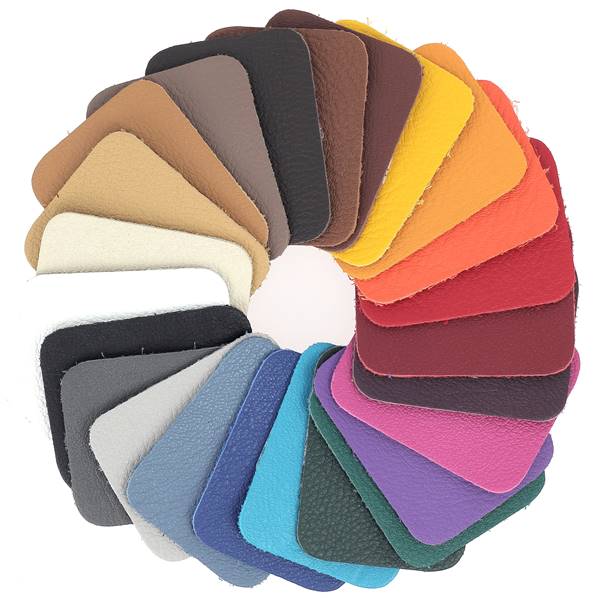


87 comments
Anonymous
Bonjour Laetitia,
Pour une sacoche de vélo, nous vous conseillons soit un cuir tannage minéral de notre gamme SATINLYS (peaux : https://www.decocuir.com/peau-veau-satinlys-c102x3811968 ou morceaux : https://www.decocuir.com/cuir-veau-morceaux-qualite-satinlys-c102x2625168). Soit un cuir tannage végétal (1,6 ou 1,9 mm d’épaisseur) : https://www.decocuir.com/morceau-cuir-tannage-vegetal-c102x2677112 (existe aussi en peaux).
Pour les poignées de vélo, effectivement le cuir automobile serait l’idéal (c’est ce type de cuir qui est utilisé pour gainer les volants). Sinon vous pouvez aussi choisir un cuir tannage végétal mais il faudra bien l’imperméabiliser, l’avantage de ce type de cuir est qu’il se patinera avec le temps !
L’équipe Deco Cuir
Anonymous
bonjour
pour faire une sacoche à vélo qui sera à cheval sur la barre, que me conseillez vous? et pour faire les poignées du vélos en cuir ce serait du cuir automobile ?
merci de votre aide!!
Anonymous
Bonjour,
Pour remplacer le cuir de votre ancien secrétaire nous invitons à sélectionner un cuir d’ameublement (qui est traité anti rayures) ou un cuir de veau/vachette de 0,8 – 1 mm d’épaisseur (en fonction du résultat souhaité).
Cuir ameublement : https://www.decocuir.com/peau-cuir-automobile-anti-uv-humidite-protege-c102x2387898
Cuir de veau : https://www.decocuir.com/peau-cuir-veau-souple-c102x2664031
Cuir de vachette : https://www.decocuir.com/peau-cuir-vachette-c102x2664033
Il faudra ensuite coller le cuir avec une colle pour cuir (base aqueuse) : https://www.decocuir.com/cuir-colle-diuant-neoprene-fort-c102x2229518
L’équipe Deco Cuir
Anonymous
Bonjour,
Je souhaite remplacer le cuir d’un ancien secrétaire. J’avoue être un peu perdue ! Pouvez vous me conseiller sur le choix d’un cuir et l’épaisseur ?
Dans l’attente de votre réponse,
Bien cordialement,
Anonymous
Bonjour,
Le cuir conseillé pour faire un bracelet en cuir est un cuir tannage végétal : https://www.decocuir.com/morceau-cuir-tannage-vegetal-c102x2677112 Il faudra choisir l’épaisseur en fonction de l’épaisseur maximum acceptée par votre Scanncut, l’idéal serait un cuir de 1,9 cm.
Nous proposons aussi déjà des découpes de bracelets en cuir : https://www.decocuir.com/diy-bracelets-en-cuir-c102x3632722
Bonne journée,
L’équipe Deco Cuir
Anonymous
bonjour,
quel cuir et épaisseur dois je prendre pour faire un bracelet que je vais découpé à la scanncut ?
Anonymous
Bonjour François,
Merci beaucoup pour votre commentaire sur notre blog ! Pour refaire des poignées de moto nous vous conseillons le cuir automobile qui est aussi utilisée pour la sellerie auto et faire les volants. Ce cuir est traité contre l’humidité et est anti-UV et très résistant :
https://www.decocuir.com/peau-cuir-automobile-anti-uv-humidite-protege-c102x2387898
L’équipe Deco Cuir
Anonymous
Bonjour,
Je découvre votre site… Superbe !!
J’aimerai savoir quel cuir utiliser pour me refaire mes poignées de moto ? Sujet à la chaleur, frottements, pluie et emploi régulier du véhicule;
Merci pour votre réponse.
Anonymous
Bonjour Delphine,
Nous vous conseillons un cuir de veau ou de vachette ferme voire mi-ferme avec une épaisseur d’au moins 1,2 mm. Voici des références de cuir qui pourront convenir : https://www.decocuir.com/peau-veau-satinlys-c102x3811968 et https://www.decocuir.com/peau-de-cuir-de-veau-imitation-serpent-marron-c2x31941146
Bonne journée, l’équipe Deco Cuir
Anonymous
Bonjour,
Je souhaiterai me faire un beau sac à main type cabas en cuir épais couleur cognac. Que me conseillez-vous comme cuir?
Merci d’avance
Anonymous
Bonjour Manuelulu,
Pour la réalisation de mini-chaps, je vous invite à choisir un cuir tannage végétal épais (au moins 1,5 mm d’épaisseur) mais souple type basane : https://www.decocuir.com/peau-entiere-de-cuir-de-basane-france-antique-vintage-chocolat-065-m-c2x28742734
Je vous laisse aussi aller voir notre gamme de cuir tannage végétal : https://www.decocuir.com/peaux-cuir-tannage-vegetal-c102x2664027
Justine de Deco Cuir
Anonymous
Bonjour,
Quelle peau me conseillez-vous pour réaliser des mini-chaps (haut de botte pour protéger les mollets du frottement des étrivières, sangles des étriers, quand on monte à cheval)?
D’avance merci!
Anonymous
Bonjour Benoit,
Effectivement nous vous conseillons de choisir un cuir de basane (tannage végétal) : https://www.decocuir.com/peau-cuir-agneau-basane-france-c102x2227515
Bonne journée !
L’équipe Deco Cuir
Anonymous
Bonjour, merci pour cette rubrique intéressante !
je souhaite recouvrir un fauteuil ancien en cuir type “fauteuil club”
Je partais sur du mouton pleine fleur mais est ce le bon choix ?, que me conseillez vous ?
Anonymous
Bonjour Pascale,
Effectivement, pour réaliser ce type de fauteuil en cuir nous invitons à sélectionner un cuir tannage végétal naturel en 1,9 mm d’épaisseur : https://www.decocuir.com/peaux-cuir-tannage-vegetal-c102x2664027
Nous serons ravis de voir le résultat !
Bonne journée et bonne année 2021. L’équipe Deco Cuir
Anonymous
Bonjour,
je désire réaliser une chaise de type “Muller van severen chair”
Quel épaisseur de cuir dois-je acheter pour l’assise ? Et quel cuir ? Je pensais acheter du cuir collet végétal naturel ?
Merci
Pascale
Anonymous
Bonjour,
Tout d’abord merci pour votre commentaire. Je vous invite à aller voir les deux fiches articles suivantes afin d’avoir des idées de créations réalisés avec une croûte de cuir ou une peau de cuir verni : https://www.decocuir.com/peau-de-croute-de-cuir-enduite-grain-dauphin-bleu-marine-b61-095-m-c2x31195176 et
https://www.decocuir.com/peau-cuir-veau-crocodile-sac-maroquinerie-imitation-c2x32591923
Au vue de l’épaisseur du cuir vous pouvez réaliser tout type de création de maroquinerie (pochette banane, trousse en cuir, pochette en cuir, porte-monnaie…) je vous invite à aller voir les tutoriels de notre blog : https://www.decocuir.com/Blog.asp?CatID=3805504
Enfin, vous pouvez bien sûr nous retourner la peau (délai de rétraction de 14 jours) en complétant le formulaire de retour : https://www.decocuir.com/formulaire-retour
Bonne journée et bonne année 2021 ! L’équipe Deco Cuir
Anonymous
Bonjour à tous .
Votre site est très bien conçu.
Pourriez-vous m’aider à prendre une décision sur un projet qui pour moi sera difficilement réalisable : Je m’explique : Je me suis procurée du cuir verni vert jade .
Pourriez-vous me dire ce que je pourrais réaliser avec ?Quelques idées de réalisation me permettraient de l’utiliser à bon escient ..
Sinon, pourrais-je vous le renvoyer ?
Très bonne continuation…
Merci.
Anonymous
Bonjour Fabienne,
Pour la création d’un marque page nous vous conseillons de sélectionner un cuir tannage végétal déjà teinté ou naturel avec une épaisseur d’au minimum 1,6 mm : https://www.decocuir.com/morceau-cuir-tannage-vegetal-c102x2677112
Bonne journée,
L’équipe Deco Cuir
Anonymous
Bonjour,
Quelle cuir pour la création d’un marque page ?
Anonymous
Bonjour Béatrice,
Nous vous invitons à choisir un cuir souple de vachette de la gamme Sweet 2 ou Granite. N’hésitez pas à aller voir notre page tutoriel avec toutes les explications : https://www.decocuir.com/tutoriel-chaussons-cuir-bebe-patron-c1200x68243
Bonne journée,
L’équipe Deco Cuir
Anonymous
Bonjour
Quel cuir utiliser pour réaliser les fameux petits chaussons pour bébé et enfants et…adultes aussi.
Cuir pour la réalisation du chaussont et pour la semelle
Merci d’avance
Anonymous
Bonjour Bouy,
Pour refaire un volant de voiture, nous vous conseillons de choisir un cuir automobile (traité anti UV et contre l’humidité) : https://www.decocuir.com/peau-cuir-automobile-anti-uv-humidite-protege-c102x2387898
Bonne journée,
L’équipe Deco Cuir
Anonymous
Bonjour
Quel cuir utiliser pour refaire un volant ?
Anonymous
Bonjour Salvatore,
Je vous invite à sélectionner un cuir tannage végétal d’une épaisseur de 3,3 mm minimum : https://www.decocuir.com/cuir-de-collet-vegetal-naturel-premium-20-x-30-cm-ep-33-mm-c2x3095061
N’hésitez pas à aller voir notre guide complet sur l’affûtage des outils : https://www.decocuir.com/strop-affuter-outil-travail-cuir-couteau-c1200x67000
L’équipe Deco Cuir
Anonymous
Bonjour,
J’aimerai du cuir à aiguiser dans un morceau de 20/30 cm. Quoi prendre ?
Anonymous
Bonjour Daniel,
Pour fabriquer une protection en cuir pour ouvrir les huîtres, je vous invite à sélectionner un cuir tannage végétal de 2,5 mm d’épaisseur : https://www.decocuir.com/cuir-de-collet-vegetal-naturel-premium-20-x-30-cm-ep-25-mm-c2x3454826$
Aussi, nous essaierons de réapprovisionner dans les prochaines semaines notre kit dédié : https://www.decocuir.com/kit-protection-ouvre-huitres-tutoriel-montage-tuto-diy-cuir-c2x24743533
L’équipe Deco Cuir
Anonymous
Bonjour,
S’il vous plait, quel cuir acheter pour fabriquer une protection en cuir pour ouvrir les huitres.
Merci beaucoup.
Anonymous
Bonjour Sarah,
Le cuir idéal pour avoir des lanières de sacs résistantes est le cuir tannage végétal d’au moins 1,9 mm d’épaisseur.
L’une des meilleures parties du cuir de bovin pour créer ces propres lanières est le collet : peau située au niveau du cou de l’animal.
Le cuir tannage végétal naturel peut-être teinté : https://www.decocuir.com/peaux-cuir-tannage-vegetal-c102x2664027
Bonne journée,
L’équipe Deco Cuir
Anonymous
Bonjour,
J’aimerais savoir quel type de cuir utiliser pour faire des sangles de sacs. J’ai le trusquin et plutôt que d’acheter des sangles j’aimerais pouvoir les couper moi-même dans un grand morceau pour faire des bandes d’environ 50 cm de long et d’une épaisseur d’environ 3mm.
Merci d’avance pour votre retour
Anonymous
Bonjour Arthuys,
Pour répondre à votre question sur notre blog, le cuir idéal pour un dessus de bureau est le cuir d’ameublement : https://www.decocuir.com/cuir-automobile-souple-morceaux-piece-anti-uv-anti-humidite-c102x1090068 que vous venez ensuite coller avec du double face ou de la colle néoprène : https://www.decocuir.com/pot-de-250-ml-de-colle-neoprene-extra-liquide-avec-pinceau-integre-au-bouchon-c2x3094948
Malheureusement nous ne vendons pas de morceaux selon vos mesures souhaitées : il faudrait donc opter pour une peaux de cuir d’ameublement ou automobile (au minimum 0,70 à 0,80 m2) : https://www.decocuir.com/peau-cuir-automobile-anti-uv-humidite-protege-c102x2387898
Bonne journée,
L’équipe Deco Cuir
Anonymous
bonjour
pouvez vous m’indiquer quel cuir en qualité il faut coller sur un secrétaire (meuble ancien)?
Vendez vous du cuir découpé au millimètre près (en l’occurrence 68,8 × 41,4 cm)?
merci
Anonymous
Bonjour Jean-Paul,
Afin de remplacer votre col en denim sur votre blouson, nous vous conseillons d’opter pour du cuir velours ou nappa avec une épaisseur d’au moins 0,8 mm. Il faudra ensuite rembourrer votre col avec de la ouatine.
Voici les catégories :
https://www.decocuir.com/peau-cuir-agneau-nappa-lisse-c102x2392093
https://www.decocuir.com/peau-cuir-doublure-c102x3752899
Bonne journée et à très bientôt,
Bien cordialement,
L’équipe Deco Cuir
Anonymous
Bonjour,
Je souhaite faire un col en cuir pour remplacer celui en denim (usé) d’un blouson.
Quel cuir choisir ?
Animal, épaisseur, souplesse etc …
Je vous remercie.
Cordialement.
Anonymous
Bonjour Marie-Cécile,
Pour faire des poignées en cuir pour vos commodes nous conseillons de choisir des lanières de collet : elles sont très résistantes et qualité premium. Elles sont aussi proposées en différentes longueurs, largeurs et épaisseurs : https://www.decocuir.com/laniere-sangle-ceinture-cuir-collet-vegetal-c102x2679725
Enfin, nous vendons aussi des poignées en cuir « prêtes à l’emploi » : https://www.decocuir.com/poignee-cuir-porte-tiroir-commode-sangle-laniere-c2x23468247
Nous vous conseillons pour travailler les tranches et aussi « protéger » l’arrière (côté croûte) de vos poignées de mettre de la gomme adragante. Je vous invite à lire la fiche article ou regarder la vidéo pour savoir comment l’utiliser : https://www.decocuir.com/gomme-adragante-finition-tranche-cuir-tannage-vegetal-c2x18625601
Bonne journée,
Justine de Deco Cuir
Anonymous
Bonjour
J’aimerais faire des poignées de commode en cuir
Pourriez-vous m’aider à choisir ?
Merci
Anonymous
Merci pour cet exposé clair et instructif pour les novices.